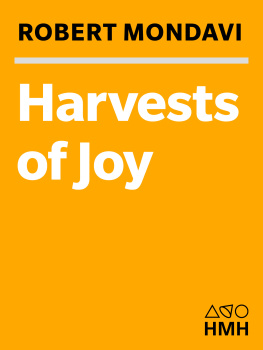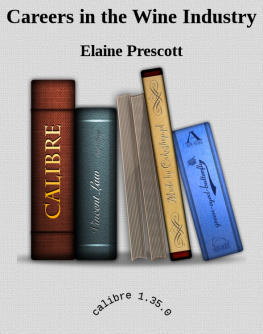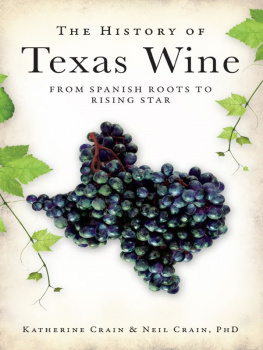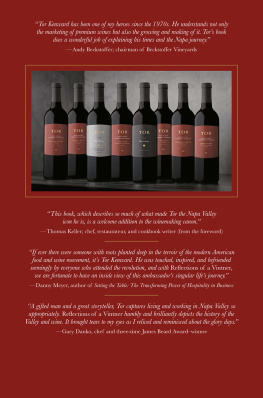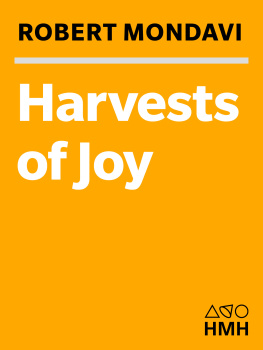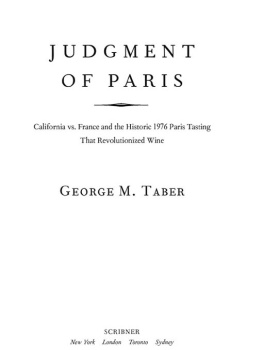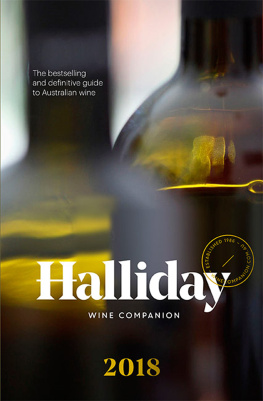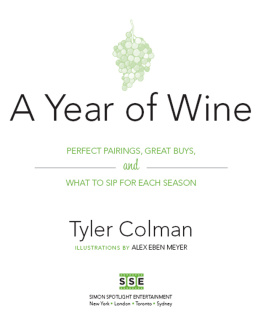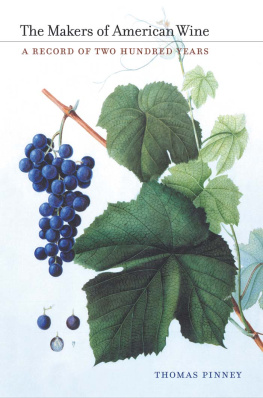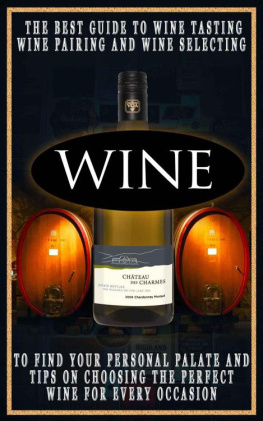Copyright 1998 by Robert Mondavi
All rights reserved. No part of this publication may be reproduced or transmitted in any form or by any means, electronic or mechanical, including photocopy, recording, or any information storage and retrieval system, without permission in writing from the publisher.
For information about permission to reproduce selections from this book, write to Permissions, Houghton Mifflin Harcourt Publishing Company, 215 Park Avenue South, New York, New York 10003.
www.hmhco.com
The Library of Congress has cataloged the print edition as follows:
Mondavi, Robert, 1913
Harvests of joy: how the good life became great business/
Robert Mondavi with Paul Chutkow.1st ed.
p. cm.
Includes index.
ISBN 978-0-15-100346-4
ISBN 978-0-15-601056-6 (pbk.)
1. Mondavi, Robert, 1913 2. Robert Mondavi
WineryHistory. 3. VintnersUnited StatesBiography.
I. Chutkow, Paul. II. Title
TP547.M66A3 1998
641.2'2'092-dc21 98-19170
[B]
First Harvest edition 1999
eISBN 978-0-547-35089-9
v2.0415
Wine is Life.
P ETRONIUS
PART ONE
THE ROOTS
Chapter 1
Heart and Soul
A T THE AGE of fifty-two, I should have been a happy man.
On the surface, life was good. The year was 1965, and America was prospering. I had a lovely, devoted wife, three delightful childrenMichael, Marcia, and Timand we lived in what I knew was one of the most idyllic spots on the planet, the Napa Valley. For twenty-three years my brother, Peter, and I had been running a small family business, the Charles Krug Winery, and we were doing pretty well. While my wife Marge and I had to be very careful about what we spent, we were secure enough to live comfortably and provide for our children.
I also adored my work. For some people in the Napa Valley, wine was just a business, an agreeable way to earn a living. Not for me. Wine for me had always been something much larger and it still is. Wine to me is passion. Its family and friends. Its warmth of heart and generosity of spirit. Wine is art. Its culture. Its the essence of civilization and the Art of Living. Wine has been with us for seven thousand years, almost since the dawn of civilization, and for centuries poets, painters, musicians, and philosophers have sung its praises. Even the Bible applauds its virtues. And wine to me is even more. When I pour a glass of truly fine wine, when I hold it up to the light and admire its color, when I raise it to my nose and savor its bouquet and essence, I know that wine is, above all else, a blessing, a gift of nature, a joy as pure and elemental as the soil and vines and sunshine from which it springs. Wine is Life, Petronius said two thousand years ago, and I know exactly what he meant.
For most men and women, what I had would have been the makings of a wonderful, contented life. But not for me. In truth, I was feeling stifled at Krug. Like so many people who reach a critical juncture in their lives and careers, I felt I was not making the most of my business savvy and creativity. I was working hard, as always, but my enthusiasm was on the wane. Throughout the 1950s and early 1960s, we had been making good table wines at Krug. We were considered to be among the Big Five of the Napa Valley, along with Beaulieu Vineyard, Inglenook, Louis Martini, and Beringer Brothers. We had built our reputation on the strength of our white wines, and our cabernet sauvignon was considered among the best in the valley. Still, I felt our ambitions were just too tame. We in California had enormous potential; I knew we could become one of the great wine-producing regions of the world. But the American wine industry was still in its infancy, and no one seemed to have the knowledge, the vision, or the guts to reach for the gold, to make wines that could stand proudly next to the very best from France, Italy, Germany, and Spain.
I wanted to move Krug in a bold new direction. In 1962 I had traveled around Europe for the first time, visiting many of the great wine-producing regions of the world to see how they made their wines. In Bordeaux, Burgundy, Tuscany, and the Moselle region of Germany, I explored some of the most prestigious wineries in the world. I toured their vineyards and cellars, examined their equipment, talked with their wine makers, and, of course, tasted their wines. Above all, in these vineyards and cellars and tasting rooms, I imbibed the spirit, the passion, and the commitment that inspired the creation of truly great wines.
Much of what I saw was a revelation. At the great chateaus, the way of growing grapes and making wine was far different from what we had been doing for generations in California. While we had one basic approach for our red wines and another for our whites, their approach was far more subtle and sophisticated. They treated each variety of grape differently, and they had a distinct method and style for each type of wine they made. We made wines in bulk, using huge tanks; they kept their output small to maximize quality, and they aged their wines in small oak barrels to create gentleness, subtlety, and complex layers of flavor. The differences ran much deeper than method and equipment. We were a big, young country, oriented toward mass production and scientific research, and in our wine making we emphasized crop yields, sugar levels, and profit margins. The great European wineries, with centuries of tradition and craft behind them, put their emphasis on less tangible qualities such as style, character, and bouquet. To my mind, the contrast was stark: we were treating wine as a business; the great European chateaus were treating wine as high art.
This realization stirred something deep inside me, but I did not understand what until one day when Marge and I had lunch at La Pyramide, one of the great restaurants of France and the world. I still remember that day vividly. I had a meeting that morning in Lyons with a potential business associate, and Marge and I had a huge breakfast with him. Talking, discussing business, we lingered at the table until about eleven oclock. My god, I thought, here were going to have lunch in one of the best restaurants in the world, one with three stars in the Michelin Guide, and Im already stuffed! What am I going to do?
An hour and a half later, we drove into Vienne, a little village outside Lyons, and found our way to La Pyramide. The setting and atmosphere of the restaurant were tasteful and elegant, without being pretentious, and we sat down to a meal that was absolutely unbelievable. Each and every dish we tried was heavenly and distinctive, with flavors I had never tasted before. Nothing was heavy or too filling, and there were none of those rich cream or butter sauces you found in many French restaurants in those days. Every forkful was light and pure in the mouth; in every bite we could taste the passion and the artistry of the chef.
What really dazzled me was how each dish complemented and enhanced the other, the way the sounds of different instruments meld into a symphony. The wines we tasted during the meal were not big and bold like ours in California; they were gentle and complex, and they artfully accentuated the many sensations and feelings that the cuisine inspired. Id go so far as to say that the food and the wine transported us into a world of gentleness and balance, of grace and harmony. La Pyramide to me epitomized the artistry and aesthetics we had been discovering all across Europe, and it inspired in me both a vision and a vow:
This is the kind of wine I want to create, I told Marge. Wines that have grace and style, harmony and balance.
During my travels in Europe, I was impressed with something else: an opportunity. I saw great extremes in wine making in Europe. The First Growth Bordeaux chteausChteau Mouton-Rothschild, Chteau Lafite, Chteau Mar-gaux, Chteau Haut-Brion, and Chteau Ptrusmade marvelous wine, subtle and complex, with flavors that were always crisp and clean. And I discovered the reason: these top chteaus were all using only new French oak barrels. Almost everyone else was producing wine the exact same way their forefathers had, and the results were not, to my taste, exceptional. I found many supposedly fine wines that proved to have off characters and bacterial defects. And I saw why: they were making their wine in oak barrels that were used, not new. This was one reason for those sorts of defects and spent flavors. To my critical eye, many of the European producers seemed to be asleep, content with the status quo; and so, frankly, I saw an opening. I felt certain that we in the Napa Valley could do just as well or better! It would take time, patience, money, and a full-blown education in how to make wine the way the great Bordeaux chteaus did, but I felt sure we could succeed. And what an exciting challenge it would be!
Next page
